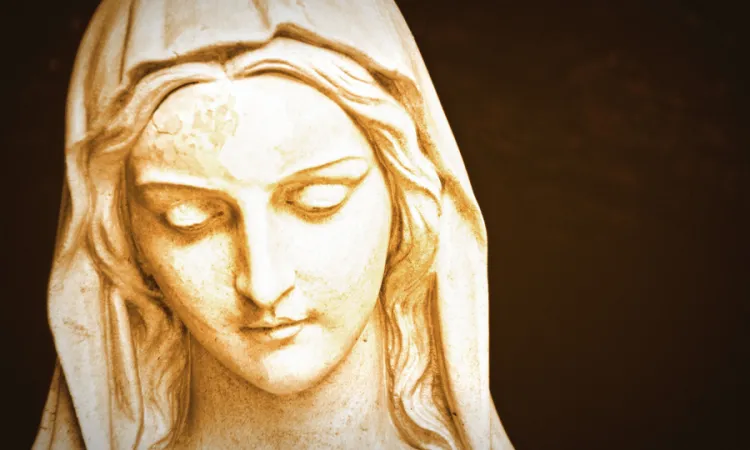The original painting is located in St. Peter's Church in Augsburg, Germany. Given its busy character and ornate decorations, a contemporary, understated icon with this title would be welcomed.
Pope Francis and Our Lady, Untier of Knots
Our Lady's ingenuity and her practical streak are captured in the title dear to the heart of Pope Francis. He has cultivated a special devotion to Our Lady depicted as the one who unties knots. While a graduate student in Germany, he was inspired by the Bavarian painting entitled, When he returned to Argentina with a copy of that image on a postcard, he had an icon struck with this same title.
Today, devotion to Our Lady under this title is growing by leaps and bounds. It can touch those beset by sudden illness, sudden financial trouble, sudden 'anything.' Devotion to Our Lady under this title is especially popular among married people, given her active role at the wedding at Cana. The feast day of Mary, "untier of knots," falls on September 28th.
More in The Way of Beauty
Untying Knots at Cana
Recall what happened at the wedding at Cana. Mary would not accept Jesus' reply-'not now.' For the married couple, the empty wine vats had to be filled immediately. Jesus needed to save the couple from disgrace now, not later. Mary played a pivotal role in untying a knotted situation at the wedding feast.
Refugees and Martyrdom in Egypt
Perhaps one of the most heartbreaking stories of the Christian Scriptures is that of the unnamed mother of the Holy Innocents whose feast day is celebrated on December 28th. To make certain that the Child Jesus born in Bethlehem would not challenge Herod's power, the king decreed that all infants under the age of two were to be killed. St. Matthew's Gospel quotes the prophet Jeremiah: "A voice was heard in Ramah, wailing and loud lamentation, Rachel weeping for her children; she refused to be consoled because they are no more" (Ch 2). Today a similar scene continues to be played out in Africa, the Mideast, and in other parts of the world, where mothers and their newborn infants are put to death for their faith.
Mary of Nazareth: the Loveliest Rose of Sharon and the Lily of the Valleys (Song of Songs 2:1)
Whether it is in literature, architecture, iconography, painting, statuary, or in music, the burst of creativity continues among artists in singing her praises. In fact, since the Middle Ages, about 15,000 hymns have been directed or addressed to Mary.
In the Christian East, Mary plays an integral role in liturgical celebrations where she is mentioned several times. Her presence in the liturgy is based on the centrality of her role in the economy of redemption. Most often addressed as Theotokos, the God-bearer, or the Mother of Life, Mary is hardly ever depicted without her son, for she is intertwined with the mystery of Jesus. She holds the God-Man and shows him to the world.
(Column continues below)
Subscribe to our daily newsletter
The Christian East praises Mary as the Virgin of Motherhood as expressed by St. John in the verse: "Woman, here is your son" (Jn 19:26). In her divine motherhood, Mary of Nazareth gave Jesus his humanity, nurtured him, and stood beside him to the very end. She is the model of all mothers. A woman, full of grace and strength, Mary is not simply a type of ideal womanhood who is placed on a pedestal. As the prototype of the Church, she inspires and assists us to untie knots in our own lives and in the lives of others.
(Addendum to last week's essay: "Little Boy Lost" may be seen on Amazon Prime.)


